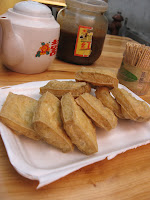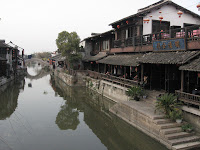上月在港時,湊巧兩個在上海的朋友都有空,我趕緊買了機票,到上海玩三天。
On my first day (20th March), one of my hosts took me for a trip and overnight stay at a nearby village called Xitang, which is supposed to be famous for its traditional scenic water views. Although Xitang was also an unknown to her, she did her homework and prepared herself to be my tour guide. Our trip started with four changes of bus from her home in the western outskirts of Shanghai. That took us a good few hours before we finally reached Xitang!
第一天(3月20日)由其中一個朋友帶我到鄰近上海的水鄉小鎮西塘逛逛兼過一夜,她以前也沒有去過,但搜集了不少資訊,自告奮勇作嚮導,從其上海西郊的家出發,結果換了四趟車,折騰了好幾小時才來到西塘!
Where we alighted was the new town part of Xitang, and it was another 15 minutes walk or so before entering the old town.
下車處仍是新城區,走進水鄉古城區也得再花十來分鐘。


The more modern side of Xitang 西塘新的一面


One of the entrances to the old town 古城其中一個入口
It was almost 14:00 when we were in the old town, so we wasted no time to find a place for a late lunch.
進入古城時已差不多下午兩點,事不宜遲,馬上醫肚!


Lunch in a little alley - consisting of noodles and 'smelly tofu'
在橫巷吃了臭豆腐(左)和麪作午飯
 Finding overnight accommodation was the next priority. It took us a while to run away from a woman who was courting hard for our custom, and we checked another two places before making up our minds. Once we were settled, it was time to start venturing.
Finding overnight accommodation was the next priority. It took us a while to run away from a woman who was courting hard for our custom, and we checked another two places before making up our minds. Once we were settled, it was time to start venturing.飯後忙着找旅店,好容易才擺脫了一個從下車以後一直形影不離招覽旅店生意的女人,再找了兩家後,安頓下來,便四出遊覽。
The village wasn’t particularly big. There were three or four major waterways running through the town, with many bridges crossing them and joining the numerous laneways and promenades into one complex labyrinth. It was only too easy to be lost and be totally immersed in appreciating the architecture preserved from ages past and the more leisurely pace of life.
水鄉不算大,有三四道大的水道貫通,但小橋可不少,與眾多小巷和水道旁的走廊連接起來,構成一個錯綜的網絡,好叫遊人走遍水鄉的每個角落,感受其古樸和悠閑的風情。


Time has probably come to a standstill in Xitang
時間的步伐在西塘停了下來


The rustic but romantic promenade of 'Misty Rain Long Corridor'
令人流連忘返的煙雨長廊
Each bridge offered a unique view of the village. The parade of houses of varying heights and designs along the waterways, together with their reflections in the tranquil water, formed one picture-perfect image after another in my mind.
走到每一道橋上,都有一番不同的景色,水道兩岸的房子,有高有矮,設計不一,反映在波平如鏡的水裡,構建成我心目中的水鄉景緻。
Different styles of bridges
不同設計的橋
Xitang is inseparable from its waters 與水相依的西塘
Songzilaifeng Bridge (left) and the nearby cruise boat pier (right)
送子來風橋(左)和附近的遊艇碼頭(右)
Restaurants at the waterside
水邊的客棧(在安境橋上一眼看到左面的永寧橋和稍遠的安秀橋)
Artistic talents won't go wasted in Xitang!
西塘到處盡是繪畫的題材
The laneways came in a variety of widths, the narrowest of which was only enough for one person to pass through. In the middle of this Shipi Lane was one of those typical old-style mansions (Zhongfu Hall) where I had a chance to look at the traditional interior architecture and décor.
小巷有闊有窄,最窄的石皮弄,僅容一人通過,中間有一家古老大宅(種褔堂),我進去參觀,見識一下裡面的建築和擺設。
Typical residential laneways 民居中的小巷
Shipi Lane
石皮弄
The very stylish 'sculptured bed' (left) and hall (right) of Zhongfu Hall
種褔堂裏面的雕花大床(左)和正廳(右)
A part of town waiting to be resurrected
正待重建的一角落
A place for storing blue roof tiles, which are becoming rarer and rarer
買少見少的藍磚瓦片
In a quieter part of town, the waterways were lined by rows of willow trees that added much liveliness to the scenery so quintessential to this region of China.
來到一道位置較僻的水道,兩旁楊柳樹甚多,令水道生色不少,好地道的江南景色啊。
Of course the waterways don't exist exclusively for the tourists!
如此美景,最宜洗濯!
After all this wandering, my friend and I found some free time in the early evening and treated ourselves to a quick snack and tea by the water while taking in the views and atmosphere.
快到傍晚,剛好有空,我和朋友附庸風雅一番,找家臨水道岸邊的店子品茶,兼品嘗其他小食。
No shortage of places for high tea, Chinese style
水邊品茗,一樂也!
The bowls of sweet dumplings and savoury tofu in a soup of dried prawns and seaweed kept us warm!
鹹豆腐花(蝦米加紫菜/海苔作湯底)和酒釀圓子,吃了令人暖和起來!
Other local delicacies, including fried beans (centre) and dumplings in sweet wine
其他特色小吃,包括炒豆子(中)和桂花酒釀(右)
The sky was dimming while we were snacking and chatting away, and the red lanterns hanging outside the buildings were gradually being lit up. After nightfall, the village became lively in another way with the water glistening in red and people congregating at the waterside for dinner. There was no better place to witness this than on a cruise boat that sailed to and back along a waterway.
我倆吃着、聊着,不覺天色漸暗,已屆華燈初上之時,掛在每家房子外的紅燈籠漸次亮起。待入夜後,一串串的紅燈籠映照水面,人群聚在水道畔用膳,為水鄉帶來另一種熱鬧的氣氛,我倆坐在觀光小艇上穿梭其中時便感受得到。
Lighting up for the evening
華燈初上
The bustling waterfront 生氣勃勃的水邊
Cruising in the dark 槳聲燈影裏
We would have enjoyed the boat ride even more if it were not for the chilly breeze onto us and the weather turning cold. It became the subject of a tease from a fellow passenger who probably did not want to be the centre of attention of those looking onto our boat from terra firma. He told us that, if he could, he would tell the on-lookers to pay more attention instead to their food or else it would cool down too fast. Although it sounded cheeky, it did contain an element of truth – my friend and I certainly felt what he meant when it was our turn for dinner!
祇可惜那晚颳起陣陣涼風,而且入夜後氣溫轉冷,坐在艇上吃風有點不好受。我們在艇上欣賞岸上景色,岸上晚膳的人也在欣賞這個「水上活動佈景」,惹來同艇上一人揶揄道:「有甚麼好看的,當心飯菜涼啊!」他所言甚是,輪到我們吃飯時,他這句話果然應驗了!
Dinner consisting of stir-fried vegetables, freshwater snails and wonton and duck soup
晚飯吃了炒菜、老鴨餛飩湯和醬爆螺螄
We still had plenty of time after dinner for a stroll around the village to take in the night views.
晚後時間還早,便到處逛逛,繼續欣賞西塘的夜景。
A world dominated by the red lanterns
份外搶眼的紅燈籠
Smelly tofu sprang up everywhere
隨處可見的臭豆腐販子
The next morning started with a dump of rain until breakfast, but sadly for us it didn’t result in the ‘mist and rain’ that my friend was hoping to see. Instead we saw a dense cloak of weekend tourists everywhere we went. Fortunately we were only planning to stay for just another hour and a bit and visit a temple called Shaoxianggang before leaving the place.
第二天起床時下過一陣雨,不過待出門時已沒甚麼煙雨可看,倒是看到星期六的人潮,一大早便擠滿每道橋和每條巷,幸好我們也祇打算再花一個多小時逛逛,參觀那個燒香港寺便離開西塘。
Entrance to a typical home in this region of China, decorated with red lanterns, stone lion statues and bamboo
古老大宅門前的石獅子、紅燈籠和富貴竹
Inside the Shaoxianggang Temple 燒香港寺內
From Xitang, we took a 20-minute bus trip to a city called Jiashan where we changed for a one-hour train trip to Shanghai. This first-ever train trip I take in mainland China was memorable from the moment the green-coloured train pulled in. It still kept its historical interior designs with hard seats and it was the slowest type of train in operation. Of course I didn’t mind too much, after all its tickets were also the cheapest. But it was also an eye-opening (and jaw-dropping) experience to be on board a train with rubbish everywhere on the floor; tobacco smoke permeating throughout the carriage; people enjoying the journey by smoking, munching and chatting while resting their feet on seats; and entertainment through radio broadcast of pop music. That probably afforded me a peek into the daily lives of the general public. At the end of the line, Shanghai offered me a completely different view again of what modern China is like. This itself is worth another blog post.
從西塘坐了大概20分鐘車到嘉善,再倒一趟火車往上海,那一小時的車程可真難忘,我們坐的是一列「綠皮車」,是全車硬座、行車速度最慢、最「歷史悠久」那款——也是車票最便宜的——那倒沒所謂,但車廂內滿地瓜子殼、骨頭及其他垃圾,乘客「悠然自得」地把腳擱在椅上,又或談天,又或抽煙,又或開餐,途中還播放電台的流行曲,總算是國內平民生活的一種寫照。到了上海,又是另一個世界,下回再分說。








































Comments
小弟拿著相機,就是拍不出一點感情,唉。
反而你的照片,可以讓我看出那邊的生活,謝。